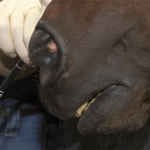Equine Glandular Gastric Disease: Diagnosing Difficulties

Equine glandular gastric disease (EGGD) has proven once again to be frustrating for both veterinarians and owners. In addition to being difficult to prevent and manage, experts recently discovered that diagnosing these lesions accurately using both gastroscopy and current guidelines may be problematic.*
EGGD is quite different from equine squamous gastric disease (ESGD), which affects the upper portion of the stomach. Causes for ulcers in the glandular or lower region remain unclear.
“Management factors such as type, frequency, and amounts of concentrates and forages do not appear to contribute to EGGD like they do squamous ulcers. Instead, training frequency and intensity and environmental factors are more likely to be predisposing factors,” said Catherine Whitehouse, M.S., a nutrition advisor for Kentucky Equine Research.
Clinical signs associated with EGGD include poor performance, mild and recurrent colic, unexplained weight loss, and decreased appetite. Changes in behavior and rideability may also be observed, such as unusual nervousness or aggression, resistance to saddling, and reluctance to move forward.
“These clinical signs alone, however, cannot be used to diagnose EGGD. Instead, lesions in the glandular region of the stomach must be directly visualized using a gastroscope,” explained Whitehouse.
To diagnose EGGD, the European College of Equine Internal Medicine (ECEIM) recommends using the following descriptors to classify lesions:**
- Location within the stomach;
- Severity—mild, moderate, severe;
- Distribution—focal, multifocal, diffuse;
- Pronouncement—raised, flat, depressed; and
- Appearance—hyperemic (red), hemorrhagic (bleeding), fibrinosuppurative (exuding fibrin strands and pus).**
As an example, the most commonly reported glandular gastric lesions are moderate, multifocal, raised, and hemorrhagic.
Previous studies, however, found poor agreement among veterinarians when evaluating the same horse for EGGD. This means veterinarians, when classifying EGGD, may not “see” the same severity, may not agree when to start or stop treatment, or may not appreciate recurrence of disease.
Believing that a group of four highly experienced veterinarians—all of whom perform gastroscopies regularly and three of whom had over 20 years of experience—could achieve better agreement, an additional study was performed.* Medical records from 84 horses that underwent gastroscopy were reviewed by all four evaluators. All records included images taken during the gastroscopy.
“The data indicated that even highly trained veterinarians failed to agree on lesion descriptions using the current guidelines,” Whitehouse said.
In fact, the only consensus the researchers came to was one of “unacceptable agreement.” “Despite the fact that differences in equipment and image quality may have contributed to the poor agreement, the evaluators suggested that the ECEIM classification system for EGGD has limited value and that alternative methods of grading lesions should be investigated.”
“Treatment strategies for EGGD include veterinary-prescribed medications such as omeprazole with or without misoprostol or sucralfate and management strategies to reduce known risk factors,” Whitehouse said. “One note: recent research has shown that omeprazole alone produces a poor success rate in healing EGGD lesions, but omeprazole and sucralfate combined offers much better results.”+
One research-proven source of sucralfate is Sucralox, a product available in Australia through veterinarians.
“Nutritional support after ulcer treatment should aim to promote gastric health and reduce inflammation, even though diet is less influential in the development of EGGD than ESGD,” she said. “A daily digestive aid can help protect the stomach by providing antacids that increase mucosal defense mechanisms as well as a time-released hindgut buffer to support the intestinal microbial population.”
*Pratt, S., I. Bowen, G. Hallowell, E. Shipman, and A. Redpath. 2022. Assessment of agreement using the equine glandular gastric disease grading system in 84 cases. Veterinary Medicine and Science:3.807.
**Sykes, B.W., M. Hewetson, R.J. Hepburn, N. Luthersson, and Y. Tamzali. 2015. European College of Equine Internal Medicine consensus statement—Equine gastric ulcer syndrome in adult horses. Journal of Veterinary Internal Medicine 29:1288–1299.
+Kranenburg, L.C., J.H.T. Scheepbouwer, and R. van den Boom. 2021. A retrospective study on the effect of combined sucralphate and omeprazole therapy compared with omeprazole monotherapy for equine glandular gastric disease. 13th Annual European College of Equine Internal Medicine Congress.








